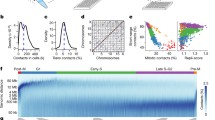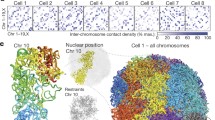Abstract
The joint role of radiation track structure and chromosome geometry in determining yields of chromosome aberrations is discussed. Ideally, the geometric models of chromosomes used for analyzing aberration yields should have the same degree of realism as track structure models. However, observed chromosome aberrations are produced by processes on comparatively large scales, e.g., misrepair involving two DSB located on different chromosomes or two DSB separated by millions of base pairs on one chromosome, and quantitative models for chromatin on such large scales have to date almost never been attempted. We survey some recent data on large-scale chromosome geometry, mainly results obtained with fluorescence in situ hybridization (“chromosome painting”) techniques. Using two chromosome models suggested by the data, we interpret the relative yields, at low and high LET, of inter-chromosomal aberrations compared to intra-chromosomal, inter-arm aberrations. The models consider each chromosome confined within its own “chromosome localization sphere,” either as a random cloud of points in one model or as a confined Gaussian polymer in the other. In agreement with other approaches, our results indicate that at any given time during the G 0/G l part of the cell cycle a chromosome is largely confined to a sub-volume comprising less than 10% of the volume of the cell nucleus. The possible significance of the ratio of inter-chromosomal aberrations to intra-chromosomal, inter-arm aberrations as an indicator of previous exposure to high LET radiation is outlined.
Access this chapter
Tax calculation will be finalised at checkout
Purchases are for personal use only
Preview
Unable to display preview. Download preview PDF.
Similar content being viewed by others
References
D.T. Goodhead. Relationship of microdosimetric techniques to applications in biological systems. Int. J. Radiat. Biol. 56: 623–634 (1989).
R.B. Painter. The role of DNA damage and repair in cell killing induced by ionizing radiation. In Radiation Biology in Cancer Research, R.E. Meyn and H.R. Withers eds., pp. 59–68. Raven Press, New York (1979).
M. Sorsa, J. Wilbourn and H. Vainio. Human cytogenetic damage as a predictor of cancer risk. larc Scientific Publications 116: 543–54 (1992).
D.C. Lloyd and A.A. Edwards. Chromosome aberrations in human lymphocytes: effects of radiation quality, dose, and dose rate. In Radiation-Induced Chromosome Damage in Man, T. Ishihara and M.S. Sasaki, eds., pp. 23–29. Alan R Liss, New York (1983).
D.J. Brenner, and J.F. Ward. Constraints on energy deposition and target size of multiply-damaged sites associated with DNA double strand breaks. Int. J. Radiat. Biol. 61: 737–748 (1992).
A.M. Kellerer. Fundamentals of microdosimetry. In The Dosimetry of Ionizing Radiation, K. Kase, B. Bjarngard and F. Attix, eds., pp. 78–162. Academic Press, Orlando (1985).
D.J. Brenner and R.K. Sachs. Chromosomal “fingerprints” of prior exposure to densely-ionizing radiation. Rad. Res. 140: 134–142.
P. Lichter, T. Cremer, J. Borden, L. Manuelidis, and D.C. Ward. Delineation of individual human chromosome aberrations in metaphase and interphase tumor cells by in situ suppression hybridization using chromosome-specific library probes. Human Genetics 80: R224–34 (1988).
H. Van Dekken, D. Pinkel, J. Mulliken, B. Trask, G. Van den Engh, and J. Gray. Three-dimensional analysis of the organization of human chromosome domains in human and hamster hybrid cells. J. Cell Sci. 94: 299–306 (1989).
J.N. Lucas, T. Tenjin, T. Straume, D. Pinkel, D. Moore, 2d., M. Litt, and J.W. Gray. Rapid human chromosome aberration analysis using fluorescence in situ hybridization. Int. J. Radiat. Biol. 56: 35–44, 56: 201 (1989).
T. Cremer, S. Popp, P. Emmerich, P. Lichter P and C. Cremer, Rapid metaphase and interphase detection of radiation-induced chromosome aberrations in human lymphocytes by chromosomal suppression in situ hybridization. Cytometry 11: 110–8 (1990).
J.W. Evans, J.A. Chang, A.J. Giaccia, D. Pinkel, and J.M. Brown. The use of fluorescence in situ hybridisation combined with premature chromosome condensation for the identification of chromosome damage. British Journal of Cancer 63: 517–21 (1991).
B.J. Trask, H. Massa, S. Kenwrick and J. Gitschier. Mapping of human chromosome Xq28 by two-color fluorescence in situ hybridization of DNA sequences to interphase cell nuclei. American Journal of Human Genetics 48: 1–15 (1991).
J.N. Lucas, A. Awa, T. Straume, M. Poggensee, Y. Kodama, M. Nakano, K. Ohtaki, H.-U. Weir, D. Pinkel, J.W. Gray and G. Littlefield, Rapid translocation frequency analysis in humans decades after exposure to ionizing radiation. Int. J. Radiat. Biol. 62: 53–63 (1992).
J.M. Brown and J.W. Evans. Fluorescence in situ hybridization: an improved method of quantitating chromosome damage and repair. Brit. J. Rad. Supplement 24: 61–4 (1992).
J.N. Lucas and R.K. Sachs. Using 3-colour chromosome painting to decide between chromosome aberration models. Proc. Nat Acad. Sci. U.S. 90: 1484–1487 (1993).
G. van den Engh, R. Sachs and B. Trask. Estimating genomic distance from DNA sequence location in cell nuclei using a random walk model, Science 257: 1410–1412 (1992).
J.F. Ward, G.D.D. Jones and J.R. Milligan. biological consequences of non-homogeneous energy deposition by ionizing radiation. Radiation Protection Dosimetry 52: 271–276. (1994).
K.E. Van Holde. Chromatin. Springer Verlag, NY (1989).
A. Wolffe. Chromatin: Structure and Function. Academic Press, San Diego (1992).
A. Chatterjee and W. R. Holley. Early Chemical Events and Initial DNA Damage. In Physical and Chemical Mechanisms in Molecular Radiation Biology, W.A. Glass and M.N. Vanna, eds., pp. 257–285. Plenum Press, NY (1992).
J.R.K. Savage, and D.G. Papworth. The relationship of radiation-induced yield to chromosome arm number. Mutat. Res. 19: 139–143 (1973).
D.J. Brenner. On the probability of interaction between elementary radiation-induced chromosomal injuries. Radiat. Environ. Biophys. 27: 189–199 (1988).
P. Hahnfeldt, J.E. Hearst, D.J. Brenner, R.K. Sachs and L.R. Hlatky. Polymer models for interphase chromosomes. Proc. Nat. Acad. Sci. USA 90: 7854–7858 (1993).
L. Hlatky L, R.K. Sachs, and P. Hahnfeldt. The ratio of dicentrics to centric rings produced in human lymphocytes by acute low-LET radiation. Radiat. Res. 129: 304–308 (1992).
L.G. Littlefield. Application of fluorescence in situ hybridization techniques in radiation cytogenetics. Radiation Research Meeting #41:126 (Dallas 1993 ).
K. Sax. An analysis of X-ray induced chromosomal aberrations in Tradescantia. Genetics 25: 41–68 (1940).
D.E. Lea. Actions of radiations on living cells. Cambridge University Press, Cambridge [Eng.] (1955).
L. Manuelidis. A view of interphase chromosomes. Science 250: 1533–4 (1990).
T. Haaf and M. Schmid, Chromosome topology in mammalian interphase nuclei. Experimental Cell Research 192: 325–332 (1991).
M. Fergusson and D.C. Ward. Cell cycle dependent chromosomal movement in pre-mitotic human T-lymphocyte nuclei. Chromosoma 101: 557–565 (1992).
J.R.K. Savage. Mechanisms of chromosome aberrations. In Mutation and the Environment, Progress in Clinical and Biological Research 340B, M. Mendelsohn and R.J. Albertini, eds., pp. 385–396. Wiley-Liss, NY (1990).
M.A. Bender, and P.C. Gooch. Persistent chromosome aberrations in irradiated human subjects. II. Three and one-half year investigation. Radiat. Res. 18: 389–396 (1963).
S. Sasaki, T. Takatsuji, Y. Ejima, S. Kodama, and C. Kido. Chromosome aberration frequency and radiation dose to lymphocytes by alpha-particles from internal deposit of Thorotrast. Radiat. Environ. Biophys. 26: 227–238 (1987).
E.J. Tawn, J.W. Hall, and G.B. Schofield. Chromosome studies in plutonium workers. Int. J. Radiat. Biol. 47: 599–610. (1985).
J. Pohl-Ruling, P. Fisher, D.C. Lloyd, A.A. Edwards, A.T. Natarajan, G. Obe, K.E. Buckton, N.O. Bianchi, P.P.W. Buul, B.C. Das, F. Dashil, L. Fabry, M. Kucerova, A. Leonard, R.N. Mukherjee, U. Mukherjee, R. Nowotny, P. Palitti, Z. Polivkova, T. Sharma, and W. Schmidt. Chromosomal damage induced in human lymphocytes by low doses of D-T neutrons. Mutat. Res. 173: 267–272 (1986).
J.S. Prosser, A.A. Edwards and D.C. Lloyd. The relationship between colony forming ability and chromosomal aberrations induced in human T-lymphocytes after y-irradiation. Int. J. Radiat. Biol. 58: 293–301 (1990).
M. Doi and S.F. Edwards. The Theory of Polymer Dynamics. Oxford Press, Oxford (1988).
R.K. Sachs, A. Awa, Y. Kodama, M. Nakano, K. Ohtaki, and J.N. Lucas. Ratios of radiation-produced chromosome aberrations as indicators of large-scale DNA geometry during interphase. Radiation Research 133: 345–350 (1993).
B. Trask, D. Pinkel, and G. van den Engh. The proximity of DNA sequences in interphase cell nuclei is correlated to genomic distance and permits ordering of cosmids spanning 250 kilobase pairs. Genomics 5: 710–17 (1991).
M.G. Kendall and P.A.P Moran. Geometrical Probability, pp. 53–54. Charles Griffin Co., London (1963).
P.M. Morse and H. Feshbach. Methods of Theoretical Physics. McGraw-Hill, New York ) (1953).
D.J. Brenner. Track structure, lesion development, and cell survival. Rad. Res. 124: S29 - S37 (1990).
S.B. Curtis. Mechanistic Models. In Physical and Chemical Mechanisms in Molecular Radiation Biology, W.A. Glass and M.N. Vanna, eds., pp. 367–386. Plenum Press, NY (1992).
R. Sachs, P-L. Chen, P. Hahnfeldt, and L. Hlatky, DNA damage caused by ionizing radiation. Mathematical Biosciences 112: 271–303 (1993).
N. Madras and A. Sokal. The pivot algorithm: a highly efficient Monte Carlo method for self avoiding walks. J. Stat. Phys. 50: 107–186 (1988).
M. Hoshi, K. Yokoru, S. Sawada, K. Shizuma, K. Iwatani, H. Hasai, T. Oka, H. Morishima, and D.J. Brenner. Europium-152 activity induced by Hiroshima atomic-bomb neutrons. Comparison with the 32P, 60Co and 152Eu activities in Dosimetry System 1986 (DS86). Hlth. Phys. 57: 831–837 (1989).
T. Straume, S.D. Egbert, W.A. Woolson, R.C. Finkel, P.W. Kubik, H.E. Gove, P. Sharma, and M. Hoshi. Neutron discrepancies in the new (DS86) Hiroshima dosimetry. Hlth. Phys. 63: 421–426 (1992).
W.C. Roesch, (ed.), US-Japan Joint Reassessment of Atomic Bomb Radiation Dosimetry in Hiroshima and Nagasaki. Radiation Effects Research Foundation, Hiroshima (1987).
A.A. Awa, and J.V. Neel. Cytogenetic ‘rogué cells, what is their frequency, origin and evolutionary significance? Proc Nat. Acad. Sci. USA, 83: 1021–1025 (1986).
J.V. Neel, A.A. Awa, Y. Kodama, M. Nakono, and K. Mabuchi. ‘Rogue lymphocytes among Ukrainians not exposed to radioactive fallout from the Chernobyl accident, the possible role of this phenomenon in oncogenesis, teratogenesis, and mutagenesis. Proc. Nat. Acad. Sci. USA 89: 6973–6977 (1992).
A.V. Sevan’kaev, A.F., Tsyb, D.C. Lloyd, A.A. Zhloba, V.V. Moiseenko, A.M. Skrjabin, and V.M. Climov. ‘Rogue cells observed in children exposed to radiation from the Chernobyl accident. Int. J. Radiat. Biol. 63: 361–367 (1993).
A.E. Romanenko. Medical consequences of the accident at the Chernobyl nuclear power station. Medical Science Academy of the USSR, Kiev (1991).
Author information
Authors and Affiliations
Editor information
Editors and Affiliations
Rights and permissions
Copyright information
© 1994 Springer Science+Business Media New York
About this chapter
Cite this chapter
Brenner, D.J., Ward, J.F., Sachs, R.K. (1994). Track Structure, Chromosome Geometry and Chromosome Aberrations. In: Varma, M.N., Chatterjee, A. (eds) Computational Approaches in Molecular Radiation Biology. Basic Life Sciences, vol 63. Springer, Boston, MA. https://doi.org/10.1007/978-1-4757-9788-6_8
Download citation
DOI: https://doi.org/10.1007/978-1-4757-9788-6_8
Publisher Name: Springer, Boston, MA
Print ISBN: 978-1-4757-9790-9
Online ISBN: 978-1-4757-9788-6
eBook Packages: Springer Book Archive




